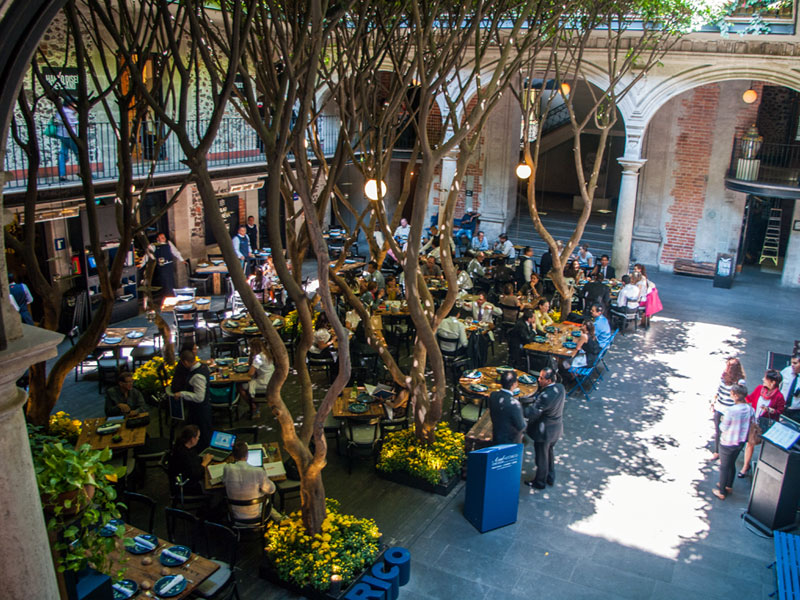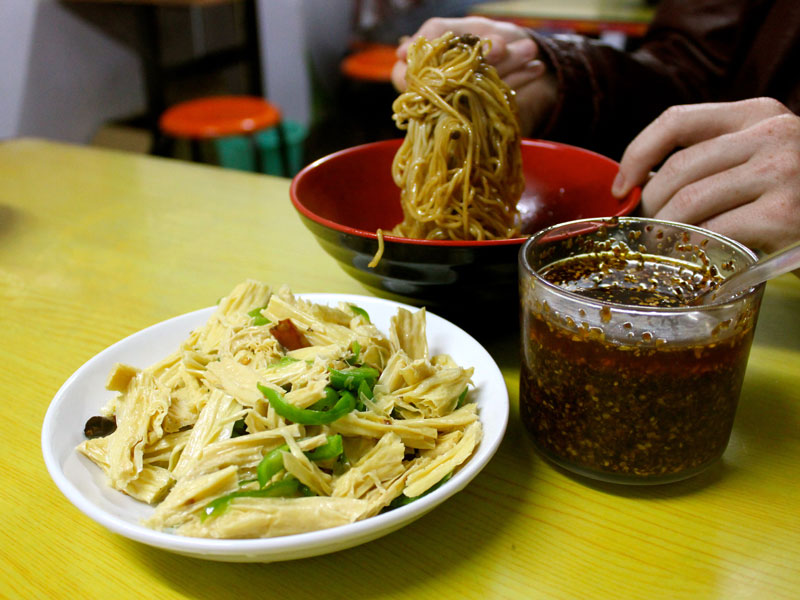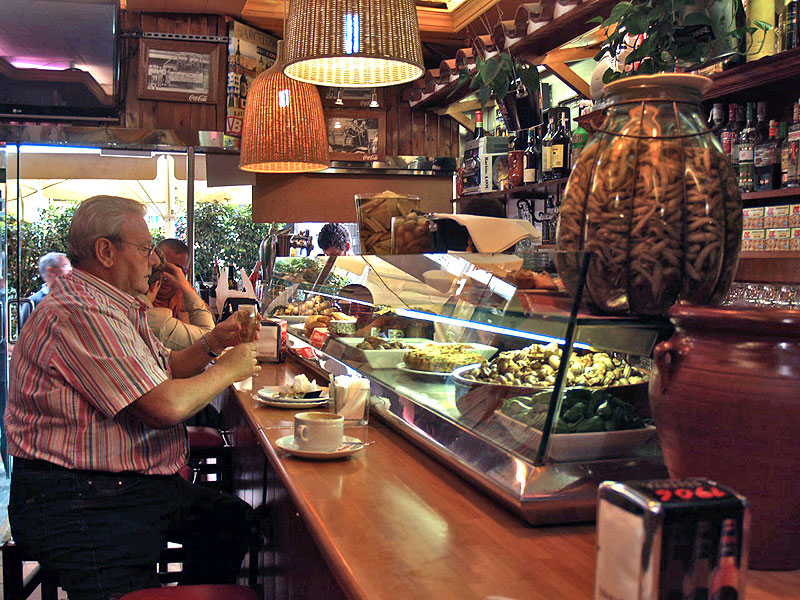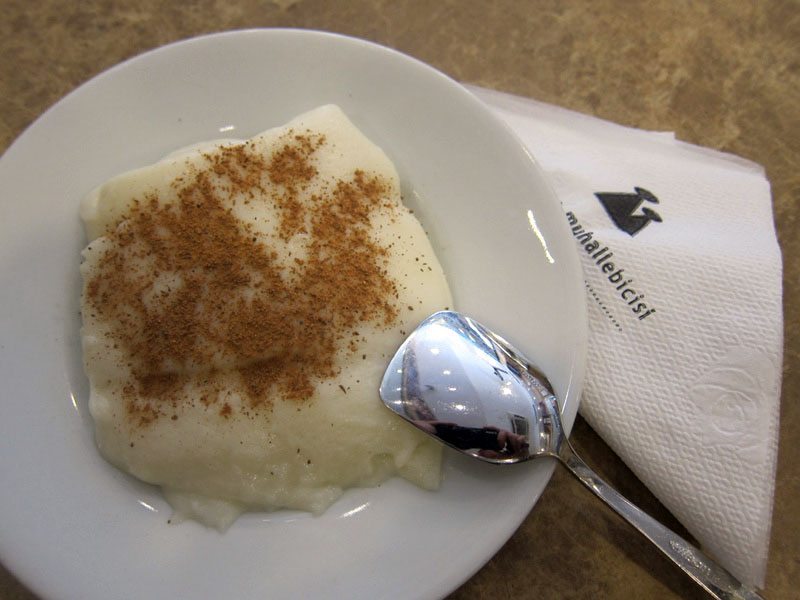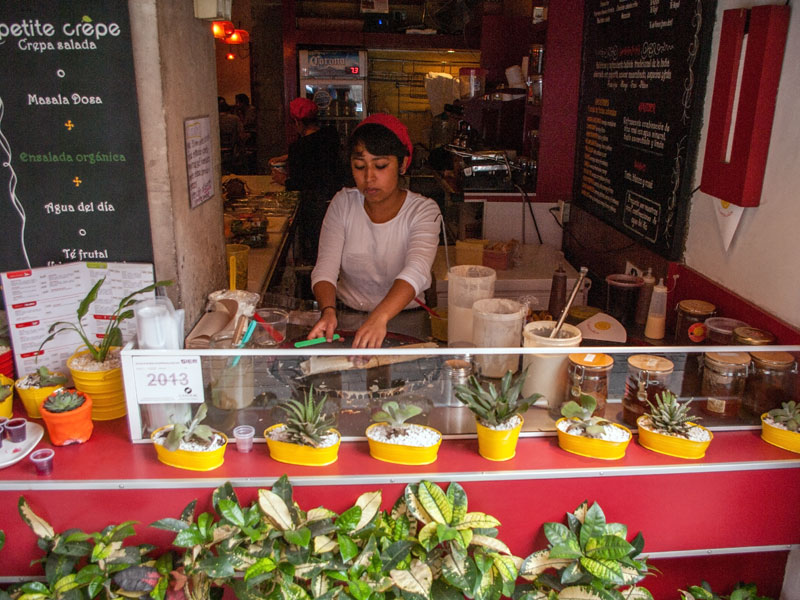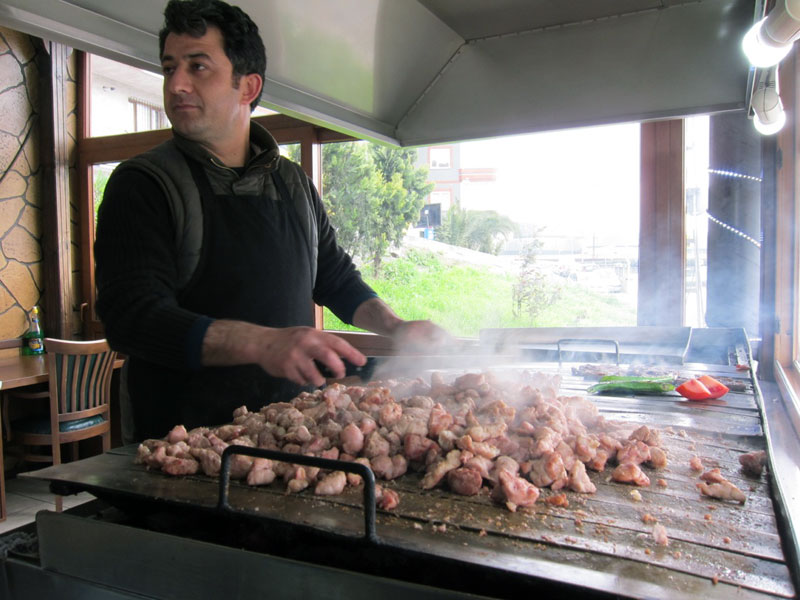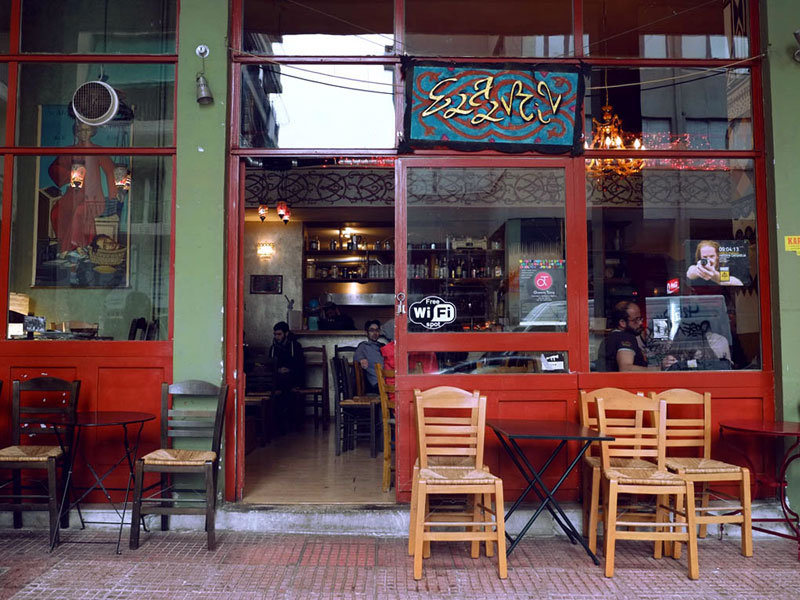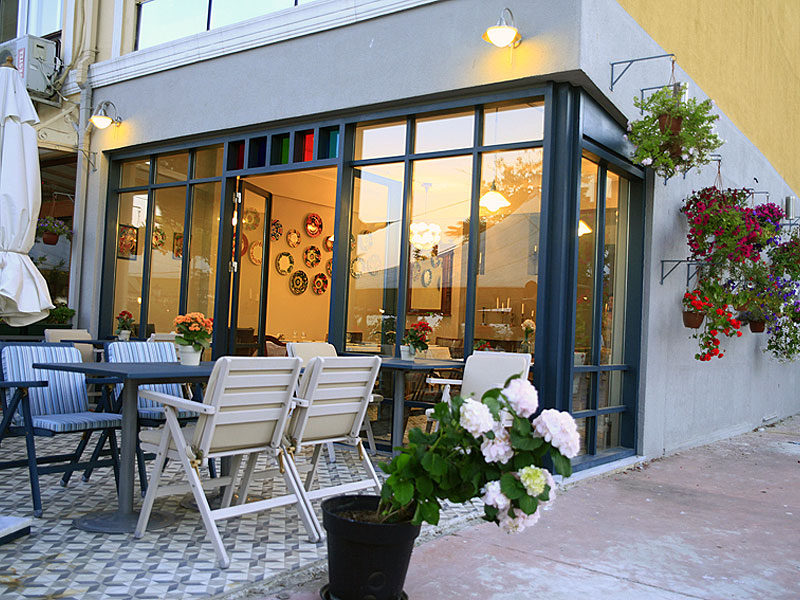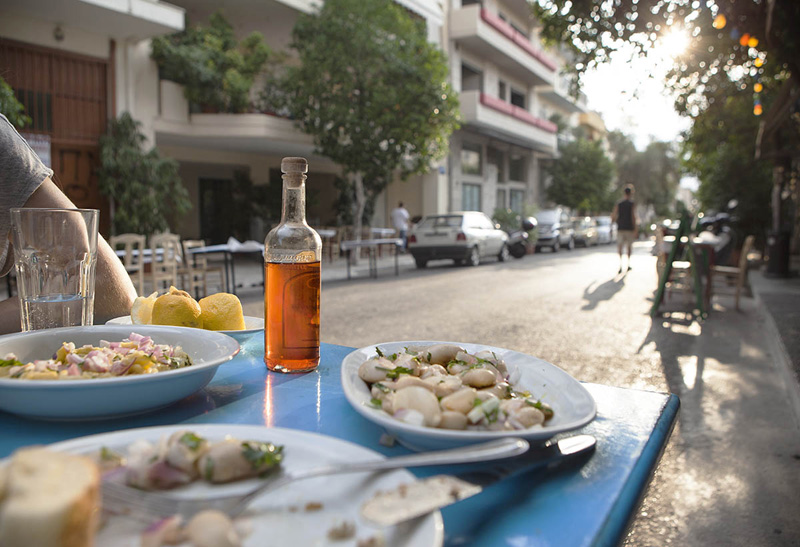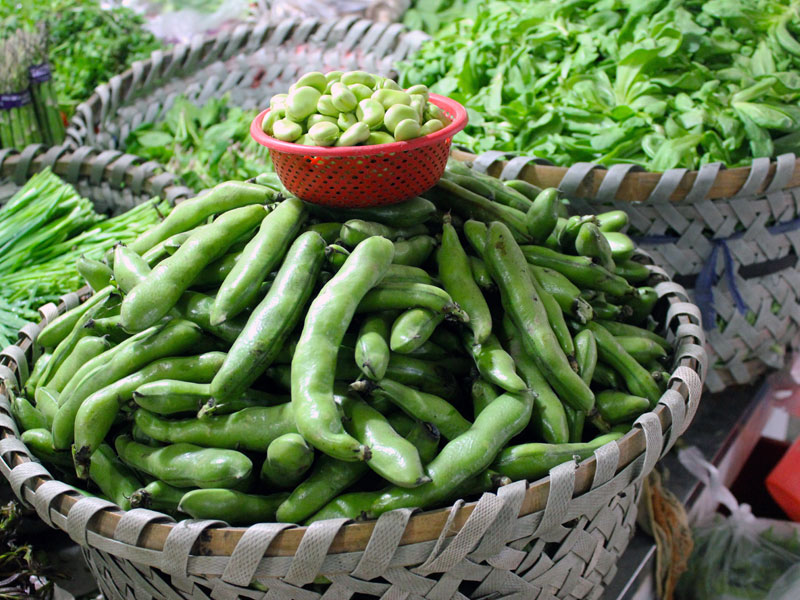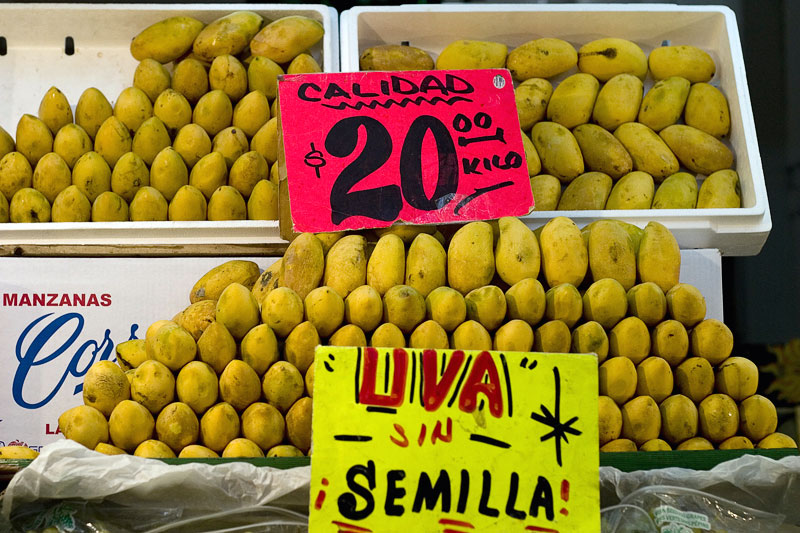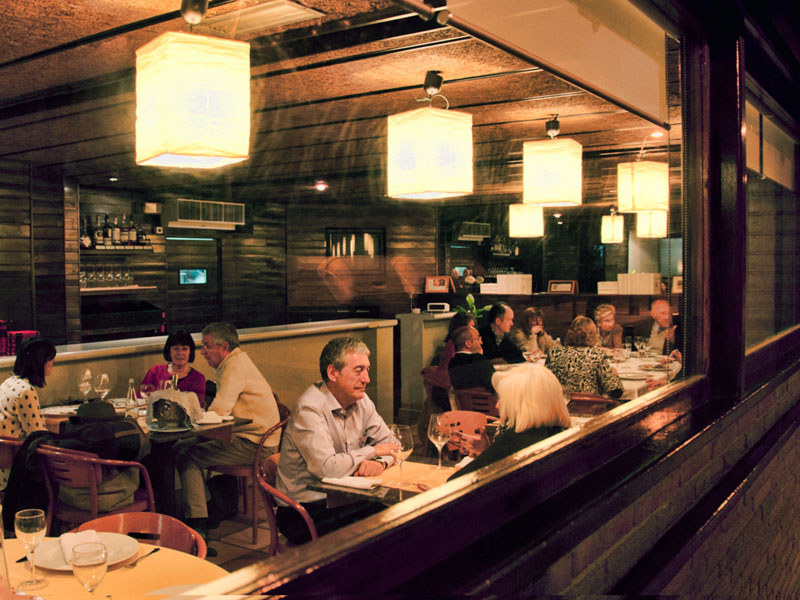We can't find the internet
Attempting to reconnect
Something went wrong!
Hang in there while we get back on track
Search results for
Mexico City
Azul Histórico: From the Files of the Culinary Detective
There wouldn’t be much of a revived culinary scene in Mexico City without chef Ricardo Muñoz Zurita. A kind of recipe detective and writer of several well-regarded Mexican cookbooks, including the superb Diccionario Enciclopédico de Gastronomía Mexicana, he has been even more successful in his restaurant ventures. After his humble Café Azul y Oro at the National Autonomous University of Mexico (UNAM) received rave reviews, he expanded on its concept – a menu of traditional regional Mexican cuisine based on sometimes forgotten recipes he had gathered through his field research – by opening a larger restaurant in the hip Condesa neighborhood in 2010. Two years later, he opened a third location in a beautifully restored building in the Centro Histórico, which has proven to be his most successful venture yet.
Read moreBarcelona
Ask CB: Local Cafés in Barcelona?
Dear Culinary Backstreets, Where can I go in Barcelona when I'm tired of sightseeing and I just want to sit down and relax with a cup of coffee? Visiting museums and landmarks can be a lot of fun when you're a tourist but sometimes you can learn more about the life of a city by sitting in a chair in a café than you can by reading any guidebook. In Barcelona, there's no shortage of cafés but like anywhere else, it can sometimes be a bit tricky to find one that has just the right ambiance.
Read moreIstanbul
Preserving Istanbul’s Soul, One Bite at a Time
We generally prefer to keep our nose in a bowl of soup and out of the political arena, but over the weekend, Istanbul’s politics seeped through the cracks in our windows, in the form of teargas and general mayhem. As longtime foreign residents of Istanbul, we’ve found it relatively easy to steer clear of political activity, but every so often it barges into our homes and turns our stomachs.
Read moreRio
Raising Cane: Cachaça’s New Day
To call someone a cachaceiro in Brazil is to deal a pretty low Portuguese blow. The word translates roughly to “drunkard” and evokes the image of an unkempt alcoholic clutching a plastic bottle of the powerful local liquor known as cachaça. It’s no coincidence that the name of the drink made with cachaça, the caipirinha, comes from the word caipira, roughly meaning “redneck” or “country.” That the national spirit is invoked in insults is emblematic of the poor image the drink has long had, but which has recently been changing. Like the newly assertive Brazil, the sugarcane-based alcohol is finding its way into chic circles where it was once seen as a bit cheap and rustic. In the past, a posh dinner host in Brazil would offer her guests a uisque (whiskey) or imported wine. But these days, it seems cariocas are finally embracing the truth: the caipirinha is a profoundly refreshing godsend on a steamy Rio summer night. A thriving cachaceiro scene is now budding both in Brazil and among a growing fan base abroad.
Read moreShanghai
Henan Lamian: The Noodle Ties That Bind
You could walk past the shoddy exterior of Henan Lamian every day without giving it a second glance, but the noodle shop hidden within is worth a double take. In our six years of eating there whenever the craving strikes (and it inevitably does, several times a week), this hole in the wall has become our local mainstay, providing cheap and consistently good noodles around the clock.
Read moreAthens
Ideal: The Institution
Editor's note: We regret to report that Ideal has closed. There is just something special about Ideal, one of Athens’ oldest restaurants, which recently celebrated 90 years in business. Perhaps it’s the marble and glass Art Nouveau entrance with gold lettering, which makes the venue look right at home next to some of the city’s architectural gems, such as the 1930s-era, New York-influenced Rex Theater, which now houses the National Theater of Greece. Or maybe it’s the restaurant’s proximity to the imposing yet decrepit Majestic Hotel just across the street and long-suffering Omonia Square nearby. Taken together, all point towards an almost forgotten bourgeois Athenian identity.
Read moreRio
Rio: State of the Stomach
Editor’s note: As of this week, Rio de Janeiro joins Culinary Backstreets as our sixth city. We’re thrilled to have expanded to four continents, and are looking forward to sharing with readers our explorations of this exciting city's dynamic food scene. Like many things in Brazil's beachside, party-hard Carnival city of Rio de Janeiro, gastronomy has a hedonistic edge to it.
Read moreMexico City
Restaurante Nicos: A Family Affair
Restaurante Nicos got its start back in 1957, when María Elena Lugo Zermeño opened a small cafeteria in the middle-class Colonia Clavería neighborhood offering family recipes passed down through the generations. Over the years, the cafeteria evolved into a full-scale – and well-known – restaurant, one that pulls in customers from across the city with its excellent dishes and warm, inviting atmosphere.
Read moreIstanbul
Istanbul's Top Street Foods
Editor’s note: This post wraps up our special series this week featuring our top street food picks in all of the Culinary Backstreets cities. As rapidly as Istanbul marches toward its modern destiny, street food in this city is still served the old-fashioned way, by boisterous ustas with a good pitch and, sometimes, a really good product.
Read moreAthens
Athens’ Top Street Foods
Editor’s note: This is the fourth installment in our street food series this week, featuring dispatches on the best streetside eating in all the cities Culinary Backstreets covers. Before we get down to the business of discussing the best of Athens’ street food, a disclaimer: Athens is at a disadvantage when it comes to streetside eats. For one thing, a lot of venues – souvlaki joints, pizza parlors and even offal soup places – are open all night or even 24/7; they are just not serving on the street, though.
Read moreBarcelona
Barcelona’s Top Street Foods
Editor’s note: This feature from Barcelona is the third installment in our series this week devoted to the top street foods in each of the Culinary Backstreets cities. In Barcelona, a great deal of eating is done in the streets. Sidewalk cafés line the plazas and paseos, often to the point that it’s difficult to tell which tables belong to which establishment.
Read moreMexico City
Mexico City’s Top 5 Street Foods
Editor’s note: This feature from Mexico City is the second installment in our street food series this week, highlighting the best streetside eats in each of the cities Culinary Backstreets covers. 1: Pambazos The pambazo is a Mexican sandwich that’s similar in style to the more familiar torta, but not nearly as ubiquitous. Most commonly found at weekly street markets like Sullivan, pambazos are made with hard, white bread rolls soaked in guajillo chili sauce that softens the crust and gives it a warm, orange-red hue. Once dried, the bread is sliced in half and then filled with a generous portion of diced potatoes, chorizo, lettuce, sour cream and sprinkled queso fresco. The bread is quite fragile, so eating the concoction can be somewhat challenging. From the first bite the pambazo starts to disintegrate, and by the end we’re usually scooping up the heavy mess with our fingers. It’s all worth it, though, as the light hint of chili in the bread and the hearty ingredients inside give the dish the same satisfying and belly-filling pleasure that comes with a good bowl of thick stew.
Read moreShanghai
Shanghai's Top 5 Street Foods
Editor’s note: This week we are celebrating street food, in all its fascinating, delicious and sometimes offbeat forms. Each day, we’ll take a look at the top street foods in a different city that Culinary Backstreets covers. This feature from Shanghai is the first installment. 1: Shengjianbao A Shanghai specialty, shēngjiān mántou (生煎馒头) – or shēngjiān bāo (生煎包), as they’re known everywhere else in China – are juicy pork buns wrapped in bread dough, then arranged in a flat, oil-slicked wok in which the bottoms are deep-fried till they are crispy. Although shengjian mantou can be found on most street corners in the morning, we’re especially fond of the delicious misshapen buns at Da Hu Chun. A Chinese Time-Honored Brand (老字号, lǎozìhào), Da Hu Chun has been splattering grease since the 1930s and, nearly 80 years later, has six restaurants across Shanghai. The venue’s chefs use the rare “clear water” technique, frying the pinched side of the dough face-up to create little Frankenstein buns that might not be as photogenic as the more common “troubled water” variety, but that have a thinner skin that gets extra crisp – and we’ll sacrifice good looks any day if it means better flavor.
Read moreMexico City
Corazón de Maguey: Mezcal Goes Upscale
The sap of the spiky maguey plant has long been used by the indigenous peoples of Mexico to prepare pulque, a milk-colored, viscous drink that has roughly the same alcohol content as beer. When they arrived in Mexico, the Spanish were introduced to pulque. Used to imbibing harder stuff, however, the conquistadors experimented with distilling a mash made out of the maguey plant, in the process inventing the beguiling spirit known as mezcal. Previously a liquor considered the province of the poor and working classes, mezcal has in recent years become one of the trendiest and most popular alcoholic drinks in Mexico, with more than 150 different brands now on the market. (Tequila, made from blue agave – a kind of maguey – and produced within a specific region of Mexico, is the best-known member of the mezcal family.) The rise in mezcal’s popularity has led to a proliferation of mezcalerías, wine bar-like spots that specialize in pouring the drink. In Mexico City in particular, mezcalerías have popped up in nearly every neighborhood, and their numbers keep growing.
Read moreBarcelona
Vermuteria Loú: Mistress of Croquettes
Located on busy Carrer de l’Escorial on the edge of Gràcia, Vermuteria Loú is a tiny, cozy venue that is exactly what we look for in a neighborhood place. The little terrace out front, with just four tables and a bar that opens to the street, encourages patrons to sit and take refreshment while observing the local street life. Inside, the scene might consist of individual drinkers slowly savoring a glass of cava at the bar while a group of men sit at the tables in the back, talking and eating one dish brought out from the kitchen after another.
Read moreIstanbul
Göreme Muhallebicisi: The Milkman Stayeth
In the world of chicken breast pudding (a traditional Turkish dessert made with thickened milk and thin strands of poached poultry), elasticity is the quality that the confection is judged upon above all else. Tucking into a real tavuk göğsü requires full concentration, a good bit of dexterity and the proper tool. A special spoon with a flat chopping nose – much like a spade – was designed just to deal with the situation and, as far as we know, this utensil is found exclusively in Turkish pudding shops. So when we got a tip about a muhallebici where “the tavuk göğsü stretches off the spoon much farther than you could fathom,” we knew we’d be dealing with the genuine article.
Read moreShanghai
Baijiu: China’s Firewater
Drinking báijiǔ (白酒) always brings us back to our first illicit taste of hard alcohol – a shock to the system, going down fiery and leaving a shudder-inducing aftertaste on the tongue. And just as many first-time drinkers are left wondering where exactly the attraction lies, the same thing is true for baijiu – at least, until the aftereffects start to kick in. In fact, even the Chinese believe that one needs to drink 300 shots over time in order to truly understand the appeal of baijiu.
Read moreMexico City
La Petite Crepe: French for Tortilla
Update: This spot is sadly no longer open. As diverse Mexican food is, there are times when we just have a craving for something different, which is why we were delighted recently to discover La Petite Crepe in the Centro Histórico, a tiny eatery producing delicious crepes and tasty beverages with an international pedigree.
Read moreIstanbul
Ask CB: Dining with Kids in Istanbul?
Dear Culinary Backstreets, My husband and I are planning a visit to Istanbul with two little ones in tow. We love to be adventurous with food and want to explore the city’s culinary scene, but are also a bit concerned about finding “child-friendly” places to eat. Do you have any recommendations?
Read moreAthens
Melilotos: The Greek Classics, Reinterpreted
Painted in hues of pistachio green, the new Melilotos is now located in the heart of Athens’ traditional shopping district on Kalamiotou Street, in a neighborhood that is well known for shops selling all sorts of wonderful fabrics and textiles by the meter.
Read moreBarcelona
Andorra: Vintage Revival
As a child, Manel Palou spent hours playing in the kitchen of Andorra, his parents’ restaurant in Barcelona’s Barrio El Born. Later, as a teenager, he helped out behind the counter while his brother Miki cooked in the kitchen. Originally bought by his grandfather in 1952, the small restaurant had been around for as long as anyone could remember; even the old-timers in the neighborhood can’t remember where the name comes from or who the previous owners were. Then in 2004, Manel’s parents decided to sell Andorra and retire. Within six years, the restaurant went from being a neighborhood favorite to a mediocre Italian joint with few clients and little charm.
Read moreAthens
Greek Easter Week, Dish by Dish
Forget about Christmas. In Greece, Easter is the main event, one where food, naturally, plays a starring role. It is also very much a holiday celebrated in the countryside: most Athenians go back to their villages during the holiday to be with their extended family and enjoy the Easter-related culinary delights of their home region.
Read moreAthens
The “Migrant Kitchen” Lands in Athens
The idea behind the “Migrant Kitchen” lunch series, first organized in Istanbul this fall by Istanbul Eats and Culinary Backstreets, is simple: get locals to sample the food of some of the immigrant communities living in their city and, through that experience, to learn more about those often invisible communities. In Istanbul, the series gave locals a taste of some fantastic Cameroonian, Liberian and Ethiopian delicacies.
Read moreBarcelona
Quimet & Quimet: Little Shop of Treasures
With its high walls lined top-to-bottom with a colorful array of bottles, the tiny Quimet & Quimet, a charming tapas bar in El Poble Sec, could easily be mistaken for just another wine shop. But step inside this culinary cabinet of wonders, one of the most famous and beautiful bodegas de tapas in Barcelona, and you will be magically whisked into another world of edible and drinkable delights.
Read moreIstanbul
Liman Uykuluk: Sweetbreads for the People
Though it may seem bewildering or even exotic to outsiders, Istanbul’s commercial life is actually organized according to a very old, guildlike system that assigns different neighborhoods to the sale and sometimes manufacture of different types of products. If you bottom out in a pothole and need a rot balans, you head up to the Oto Sanayi area. For kitchen and bathroom accessories, the Çağlayan neighborhood is the answer. And when Istanbulites hanker for grilled sweetbreads, or uykuluk, the only suitable place to go is Sütlüce, down where the slaughterhouses used to operate on the Golden Horn.
Read moreMexico City
Hilaria Gastrobar: A New Look in the Old City
Update: This spot is sadly no longer open. Until not long ago, Francisco I. Madero was a typical – and rather uninviting – street in Mexico City’s Centro Histórico, uneven and full of potholes, with narrow sidewalks. The avenue was constantly clogged with car traffic trying to make its way to the Zócalo plaza in the center of the neighborhood. In short, it was a mess.
Read moreIstanbul
In Istanbul, a Workers’ Lunchtime Paradise Lost
In the realm of Turkey’s small businesses, the esnaf lokantası (tradesmen’s restaurant) hovers above everything like a uniting holy spirit. A good one certainly is divine in nature. Take just about any old esnaf lokantası, and you’re sure to encounter a community that only exists at that particular spot on earth.
Read moreShanghai
A Niang Mian: Grandma’s Noodles
In 2008, Shanghai’s noodle scene was dealt a mighty blow. A Niang, a granny from the ancient seaport of Ningbo who was famous among local foodies for her seafood noodles, was forced to close her streetside shop after being diagnosed with kidney disease. Over the past few decades, she’d gained a loyal following; her friendly, wrinkled face was a common sight in the dining room, as she often wandered through the hordes of hungry diners to say hello to regulars or wipe up a splash of spilled soup.
Read moreBarcelona
Pa de Sant Jordi: Barcelona's Bread of Love
In Barcelona, Valentine’s Day is no big deal. On the other hand, on April 23, you had better remember to buy a flower for your sweetheart. La Diada de Sant Jordi is one of the most important holidays in Catalonia, honoring its patron Saint George. The Catalan tradition – inspired by the legend of Saint George’s chivalrous slaying of a dragon to save a princess – is for men to buy roses for women and, in return, for women to buy books for men.
Read moreMexico City
Mexico City Tries to Shake Off Its Salt Habit
Mexican dishes are known for their bold flavor combinations, from complex mole sauces that incorporate ingredients as diverse as chilies and dark chocolate to the multiple different food items and seasonings that go into an authentic pozole. But an equally key element in Mexican food culture is that most basic of flavorings: salt. From savory dishes to fruit and candy to alcoholic beverages, Mexicans have a taste for – and a habit of – pairing salt with almost everything.
Read moreAthens
Museum Quality: Dining in Athens’ Cultural Institutions
Considering Athens’ position as a top tourist destination, it may come as a surprise that it is only recently that local museums have decided to up their game when it comes to their dining offerings. Worldwide, a good restaurant and café are now considered part of the whole museum-going experience, but it took a little time for Athenian museums to catch on to that, though catch on they have.
Read moreShanghai
Chenghuang Miao Tese Xiaochi: Divine (and Delicious) Madness
On the diner intimidation scale, Shanghai’s Chenghuang Miao Tese Xiaochi – which can be loosely translated as “City God Temple Snack Shop” – ranks pretty high, with aggressive lunchtime crowds and nothing but Chinese character-laden menus for guidance. But the payoff, a baptism by fire in authentic Chinese eating, is worth it. The hungry masses that congregate here have discovered a simple truth: the food here is quick, tasty and cheap – a gastronaut’s holy trinity.
Read moreMexico City
Las Laguneras: The Right Stuff
Update: This spot is sadly no longer open. Come Sunday, we often find ourselves strolling through leafy Parque Sullivan, which hosts Mexico City’s largest outdoor art market. The art here ranges from modern to whimsical, abstract to landscapes, created by artists who no doubt have dreams of being the next Diego Rivera or Frida Kahlo. When we get hungry, we usually head over to nearby Sullivan Market to get a taste of the culinary artistry of the food vendors working there. But on a recent Sunday, we decided to follow the advice of friends and try something new in the neighborhood: the gorditas over at Las Laguneras.
Read moreIstanbul
Perazin: That Old Meyhane Magic
Update: This spot is sadly no longer open. In an opinion piece published recently in the Latitude blog of The New York Times, veteran Turkey correspondent Andrew Finkel’s brutally honest appraisal of the state of “New Turkish Cuisine” called much of Istanbul’s restaurant establishment – down to the customers – into question. We’ve had similar misgivings after meals in some upscale nouveau meyhanes where fussy food and too much attention to interior design end up spoiling an atmosphere that is supposed to be fun.
Read moreAthens
Saladin: The Meze Conqueror
Editor’s note: We’re sorry to report that Saladin has closed. The mezedopoleio – a type of venue where mezes are passed around for all to eat – is traditionally associated with students more interested in getting drunk on cheap alcohol than savoring a nice meal. But tough times require hard drinking, which means that mezedopoleia have recently made a massive comeback in Athenian life. In the historic Keramikos area, Saladin is a venue that does double duty, fulfilling the traditional function of the mezedopoleio while taking the food component up several notches.
Read moreBarcelona
El Jabalí de Ronda: Hams and Roses
Editor’s note: We regret to report that El Jabalí de Ronda has closed. Barcelona’s Avinguda del Paral·lel was, for the first half of the 20th century, a bustling boulevard of theaters, cabarets, circus shows and risqué nightlife. Nowadays, most of the grand buildings and the glamour of the thoroughfare have been erased by the rapid changes that have taken place in Barcelona, with just a few theaters and old bars from the glory days still open. Thankfully, one of the holdouts is the quirky El Jabalí de Ronda, a combination delicatessen, butcher shop and tapas bar, which still welcomes customers with its signature legs of acorn-fed Iberian ham and its cozy terrace and vases of freshly cut flowers.
Read moreIstanbul
Heyamola Ada Lokantası: Island Time
While the Princes’ Islands make for a great escape from the city, it used to be hard to think of them as a culinary destination. That is, until Heyamola Ada Lokantası opened. The restaurant is a perfect storm of inspired food, chill ambiance and small-label Turkish wines, all at ridiculously low prices.
Read moreAthens
Therapeftirio: Diner, Heal Thyself
The literal translation for Therapeftiriο is “sanatorium,” which in this case refers not to what this restaurant might have once been but rather to the ancient Greek belief that having a good time by eating good food and drinking good wine can cure your troubles. It’s an old-fashioned name in an old-fashioned neighborhood that is fast becoming a hipster area.
Read moreMexico City
Cruz del Milagro: The Magnificent Seven (Moles)
Editor's Note: Sadly, this spot is now closed. Sometimes bureaucracy can be a blessing in disguise. Cruz del Milagro, an informal restaurant in the popular nightlife area of Zona Rosa, was originally intended to be a simple mezcalería, a place where owners Dora Jiménez and daughter Diana Herrera, the third and fourth generation in a line of mezcal producers, could share the family brand, El Rey Zapoteco Mezcal, with the growing base of mezcal aficionados in Mexico City. They were informed, however, that because of a city law, they would either have to also serve food or open a traditional full bar. Fortunately, they chose the first option and decided to focus on the specialties of their home state of Oaxaca, resulting in a menu that’s far from being an afterthought.
Read moreBarcelona
Ask CB: Eating Early in Barcelona?
Dear Culinary Backstreets, I hear that Spaniards take their dinner very late. Are there any good restaurants in Barcelona that start serving dinner before 9 p.m.? Indeed, Spaniards are notorious for eating late. Even when dining at home, the typical Spanish family doesn’t eat their dinner until around 9 or 10 p.m. – or sometimes even later! The main reason for this is that for most people in Spain, lunch – which usually consists of at least two courses and is eaten at some point between 1:30 and 4 p.m. – is the most substantial meal of the day. It makes sense, then, that nobody has much of an appetite again until late in the evening.
Read moreShanghai
Lotus Eatery: Minority Cuisine Report
Ever since former President Deng Xiaoping opened China’s economic doors to the rest of the world starting in 1979, foreigners wishing to do business in China have had to find a local partner to form a joint venture company. Though no longer a hard-and-fast requirement, that’s still the modus operandi at Lotus Eatery, where a founding partnership brings together the best of both culinary worlds: unusual yet authentic local flavors and distinctly foreign notions of consistent quality and attentive service.
Read moreIstanbul
Siirt Şeref Büryan Kebap Salonu: The Lamb Underground
Kadınlar Pazarı – a pleasant, pedestrian-only square in Istanbul’s Fatih neighborhood – is the closest thing the city has to a “Little Kurdistan.” The area is populated by migrants from Turkey’s predominantly Kurdish southeast region, and small market stalls and butcher shops selling honey, cheeses, spices and other goodies from the region surround the square. Visiting the atmospheric area is a great way to get a taste of Southeast Turkey without having to leave Istanbul.
Read moreIstanbul
Spring (Food) Break 2013: Istanbul
Editor’s note: This is the fourth installment of “Spring (Food) Break 2013,” featuring our favorite foods of the spring season in each city Culinary Backstreets covers. This year’s Nevruz celebration, an ancient welcoming of spring, may be remembered for its political significance in which a peace deal was struck between Turkish leaders and Kurdish rebels. But once the shoulder-shrugging, line-dancing, fire-jumping and ululating are over, the real bounty of the season will continue to be celebrated all over Turkey and in many Istanbul restaurants, from the chic to the shabby.
Read moreShanghai
Spring (Food) Break 2013: Shanghai
Editor’s note: This is the third installment of“Spring (Food) Break 2013,” a look at our favorite springtime foods in the cities Culinary Backstreets covers. In Shanghai, wet markets hold the telltale signs that spring is finally upon us. Stalks of asparagus as thick as a thumb spring up first, alongside brown and white bamboo shoots so freshly pulled from the earth that dirt still clings to their fibrous shells. But the most exciting spring green is fava beans (蚕豆, cándòu), also known as broad beans. Their short season in Shanghai – usually just about four to five weeks – means they’re in high demand, and stalls are filled with workers shelling the labor-intensive beans by the bushel.
Read moreMexico City
Spring (Food) Break 2013: Mexico City
Editor’s note: This is the second installment of “Spring (Food) Break 2013,” our weeklong celebration of spring’s culinary bounty. This guest post is by Lesley Téllez, a freelance writer and the author of the blog The Mija Chronicles, who recently moved to New York after four years in Mexico City.
Read moreAthens
Spring (Food) Break 2013: Athens
Editor’s note: Here at Culinary Backstreets, we eagerly await the coming of spring each year, not just for the nicer weather but also because some of our favorite foods and dishes are at their best – or indeed, are only available – for a short period during this season. This post from Athens is the first installment of “Spring (Food) Break 2013,” a weeklong celebration of our favorite springtime eats. Stay tuned for dispatches from all of the Culinary Backstreets cities. Athens is probably at its prettiest in springtime, especially in April and May.
Read moreMexico City
In Mexico, a Cuisine Born from Corn
Humanity came from corn, or so says the Mayan creation story, the Popol Vuh. After creating the earth and animals, the story goes, the Maker decided to create beings in his likeness. After failing twice with dirt and wood, the Maker formed man and woman out of the “nourishing life” of ground corn. And so began Mexico’s deep relationship with one of the most widely used crops in human history, one that seems to be present in almost every aspect of Mexican cooking.
Read moreBarcelona
Restaurant Roma: Comfort Food, Catalan Style
At first glance, Restaurant Roma doesn’t appear to be anything out of the ordinary. The nondescript brown tiles covering the floors, the dark wood bar, the vaguely Mediterranean-inspired wall décor and the rectangular paper Ikea lamps are similar to those at hundreds of other midrange restaurants throughout Barcelona. Situated on a quiet street in residential Sant Gervasi, Roma isn’t somewhere you’d be likely to come across accidentally, nor is it the kind of place you’d happen to hear about, unless you (or your aunt, or coworker or a friend of a friend) lived nearby. And that would be a shame because the food at Roma is good – ridiculously delicious, in fact.
Read more